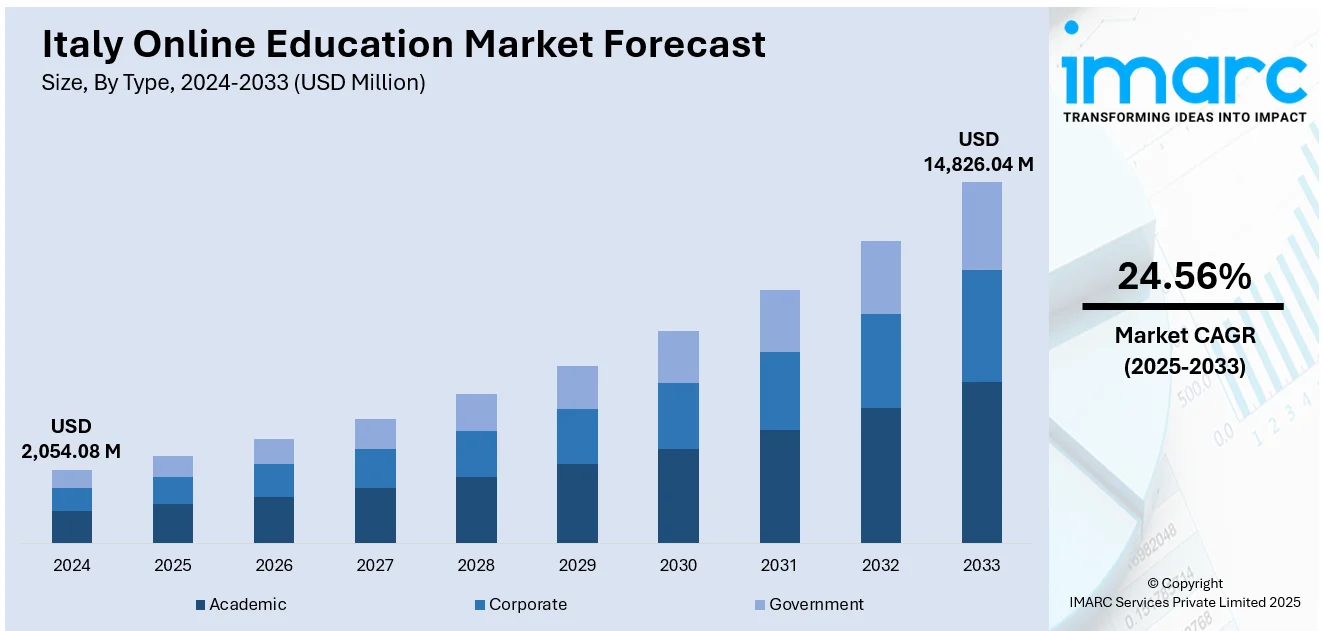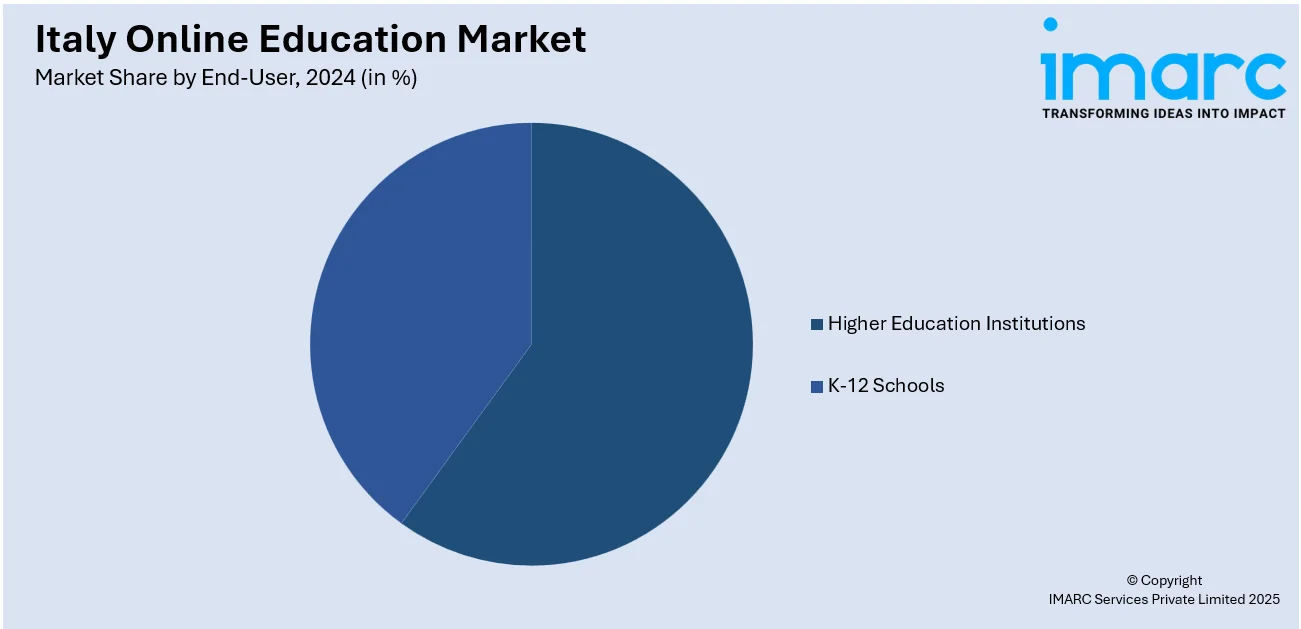
Italy Online Education Market Size, Share, Trends and Forecast by Type, Provider, Technology, End-User, and Region, 2025-2033
Italy Online Education Market Overview:
The Italy online education market size reached USD 2,054.08 Million in 2024. The market is projected to reach USD 14,826.04 Million by 2033, exhibiting a growth rate (CAGR) of 24.56% during 2025-2033. The market is fueled by growing adoption of digital solutions through the academic, vocational, and professional learning segments. Digital inclusion supported by the government, growing need for flexible learning, and university-driven hybrid models are central contributors. Advancements in technology like artificial intelligence (AI) integration and customized learning streams further bolster engagement as well as accessibility. Strong involvement of adult learners and professionals looking for reskilling is also being seen in the market. These factors collectively drive the growth of the Italy online education market share.
|
Report Attribute
|
Key Statistics
|
|---|---|
|
Base Year
|
2024
|
|
Forecast Years
|
2025-2033
|
|
Historical Years
|
2019-2024
|
| Market Size in 2024 | USD 2,054.08 Million |
| Market Forecast in 2033 | USD 14,826.04 Million |
| Market Growth Rate 2025-2033 | 24.56% |
Italy Online Education Market Trends:
Vocational and Lifelong Learning Platforms Expansion
Italy has experienced a remarkable increase in online education platforms focused on vocational training and lifelong learning. Such platforms serve career-conscious professionals that are in pursuit of career progression, reskilling, or professional certifications in technical fields including design, coding, marketing, and language teaching. Government-sponsored programs aimed at encouraging continuous learning have stimulated institutions to create modular, flexible, and self-directed courses that are available on mobile devices. Micro-credentialing systems are also being integrated, enabling students to collect trackable certifications for technical skills. This development is part of Italy's efforts towards enhancing the overall adaptability and competitiveness of its labor force in the European job market. Inclusiveness, accompanied by the integration of local language provision, is another indicator of the country's drive towards digital equity. Italy online education market expansion is apparent in the rising enrollment levels and engagement on platforms, particularly for working adults and university graduates, as digital education emerges as a convenient addition to more conventional in-class teaching.

To get more information on this market, Request Sample
Integration of Artificial Intelligence and Adaptive Learning
The integration of artificial intelligence (AI) into Italy's online education platforms is a revolutionary direction, allowing for more personalized and effective learning processes. Adaptive learning algorithms measure student performance in real time to drive content difficulty, recommend personalized materials, and provide interactive feedback. AI tutors and automated testing tools now exist as part of most platforms, supporting better learning outcomes and learner motivation. Such technologies are especially salient in STEM and language learning, where real-time correction, pronunciation support, and practice modules are critical. Italian teachers are also investigating AI to assist students with disabilities in learning, pushing further the scope of inclusive digital learning. This tech trend occurs alongside European digital learning strategies and mirrors growing demands on smart systems in academic and business training environments. The Italy online learning market trends identify this expanding usage of artificial intelligence (AI) as a central element in platform design and course innovation. According to the reports, in September 2023, Italy's second NextEdu accelerator opened at OGR Torino, picking 8 international EdTech startups—including 4 Italian companies based on AI, LMS, e-learning, and online education innovation.
University-Led Digital Transformation and Hybrid Learning
Italian traditional universities are also evolving digitally, integrating online platforms with face-to-face learning into stable hybrid models. Such developments enable institutions to uphold academic standards while providing flexible access to lectures, exams, and ancillary content. Recorded lectures, online libraries, and distance mentoring have become integral elements of university life, particularly for postgraduate and continuing education courses. Combining with research facilities and scholarly networks in Europe is promoting the building of innovative curriculum that comes up with new solutions to evolving global issues through virtual learning environments. The reactions of students have been very impressive, with higher enrollment and retention rates in blended courses. These initiatives advance the digitalization objectives of Italy's national education policies and advance scholarly resilience during interruptions. As per the sources, in September 2024, Italy started piloting AI teaching in schools with virtual classroom assistants in place to enhance IT skills in the framework of the nation's overall digital education transition. Moreover, emphasizing Italy online education market growth, universities are becoming central players in developing a sustainable and inclusive digital learning environment that reaches beyond traditional learners across geographies.
Italy Online Education Market Segmentation:
IMARC Group provides an analysis of the key trends in each segment of the market, along with forecasts at the country and regional levels for 2025-2033. Our report has categorized the market based on type, provider, technology, and end-user.
Type Insights:
- Academic
- Higher Education
- Vocational Training
- K-12 Education
- Corporate
- Large Enterprises
- SMBs
- Government
The report has provided a detailed breakup and analysis of the market based on the type. This includes academic (higher education, vocational training, and K-12 education), corporate (large enterprises and SMBs), and government.
Provider Insights:
- Content
- Services
A detailed breakup and analysis of the market based on the provider have also been provided in the report. This includes content and services.
Technology Insights:
- Mobile E-Learning
- Rapid E-Learning
- Virtual Classroom
- Others
The report has provided a detailed breakup and analysis of the market based on the technology. This includes mobile e-learning, rapid e-learning, virtual classroom, and others.
End-User Insights:

- Higher Education Institutions
- K-12 Schools
A detailed breakup and analysis of the market based on the end-user have also been provided in the report. This includes higher education institutions and K-12 schools.
Regional Insights:
- Northwest
- Northeast
- Central
- South
- Others
The report has also provided a comprehensive analysis of all the major regional markets, which include Northwest, Northeast, Central, South, and others.
Competitive Landscape:
The market research report has also provided a comprehensive analysis of the competitive landscape. Competitive analysis such as market structure, key player positioning, top winning strategies, competitive dashboard, and company evaluation quadrant has been covered in the report. Also, detailed profiles of all major companies have been provided.
Italy Online Education Market Report Coverage:
| Report Features | Details |
|---|---|
| Base Year of the Analysis | 2024 |
| Historical Period | 2019-2024 |
| Forecast Period | 2025-2033 |
| Units | Million USD |
| Scope of the Report |
Exploration of Historical Trends and Market Outlook, Industry Catalysts and Challenges, Segment-Wise Historical and Future Market Assessment:
|
| Types Covered |
|
| Providers Covered | Content, Services |
| Technologies Covered | Mobile E-Learning, Rapid E-Learning, Virtual Classroom, Others |
| End-Users Covered | Higher Education Institutions, K-12 Schools |
| Regions Covered | Northwest, Northeast, Central, South, Others |
| Customization Scope | 10% Free Customization |
| Post-Sale Analyst Support | 10-12 Weeks |
| Delivery Format | PDF and Excel through Email (We can also provide the editable version of the report in PPT/Word format on special request) |
Key Questions Answered in This Report:
- How has the Italy online education market performed so far and how will it perform in the coming years?
- What is the breakup of the Italy online education market on the basis of type?
- What is the breakup of the Italy online education market on the basis of provider?
- What is the breakup of the Italy online education market on the basis of technology?
- What is the breakup of the Italy online education market on the basis of end-user?
- What is the breakup of the Italy online education market on the basis of region?
- What are the various stages in the value chain of the Italy online education market?
- What are the key driving factors and challenges in the Italy online education?
- What is the structure of the Italy online education market and who are the key players?
- What is the degree of competition in the Italy online education market?
Key Benefits for Stakeholders:
- IMARC’s industry report offers a comprehensive quantitative analysis of various market segments, historical and current market trends, market forecasts, and dynamics of the Italy online education market from 2019-2033.
- The research report provides the latest information on the market drivers, challenges, and opportunities in the Italy online education market.
- Porter's five forces analysis assist stakeholders in assessing the impact of new entrants, competitive rivalry, supplier power, buyer power, and the threat of substitution. It helps stakeholders to analyze the level of competition within the Italy online education industry and its attractiveness.
- Competitive landscape allows stakeholders to understand their competitive environment and provides an insight into the current positions of key players in the market.
Need more help?
- Speak to our experienced analysts for insights on the current market scenarios.
- Include additional segments and countries to customize the report as per your requirement.
- Gain an unparalleled competitive advantage in your domain by understanding how to utilize the report and positively impacting your operations and revenue.
- For further assistance, please connect with our analysts.
 Request Customization
Request Customization
 Speak to an Analyst
Speak to an Analyst
 Request Brochure
Request Brochure
 Inquire Before Buying
Inquire Before Buying




.webp)




.webp)












